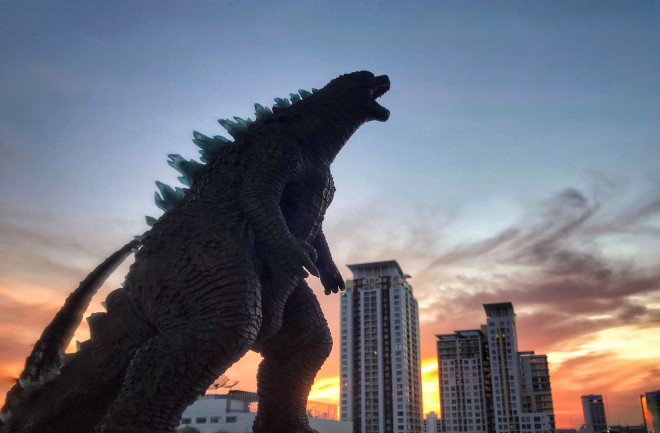On March 10, Godzilla Minus One won an Oscar for visual effects. The titan reptile has demolished Tokyo and other major cities worldwide several times in movies and has inspired generations of filmmakers and paleontologists—so much so that there are fossils named in homage to Godzilla. The fictional radioactive reptile is also the subject of fun discussion among paleontologists on what type of dinosaur it would fall under.
Although Godzilla is a product and a metaphor for the atomic bombings of Hiroshima and Nagasaki, the giant theropod does have some resemblance to ancient dinosaurs. Here are a few, as well as some that inspired the look of Godzilla:
Godzilla's Dinosaur-like Features
According to Darren Naish, a paleontologist at the University of Portsmouth, Godzilla weighs between 20,000 and 60,000 tons and is about 328 feet tall (100 m). The sea monster's characteristics are a mixture of various real-life dinosaurs.
In a 1998 essay titled, A Dinosaur Paleontologist's View Of Godzilla, Paleontologist Kenneth Carpenter states that Godzilla's sharp teeth mean it's a carnivore, and Godzilla's forward-facing eyes make it easy for the dino to catch prey or see its next target. Godzilla also walks on two legs, which is bipedal like the well-known Tyrannosaurus and Allosaurus. Godzilla's stumpy neck is comparable to Carnotaurus and Ceratosaurus.
However, unlike the Tyrannosaurus, Godzilla does not have shrimpy arms. Instead, it has long, muscular arms with four digits on its hands—perfect for giving a proper hug or whacking a building to pieces. In real life, theropods usually have shorter arms. Carpenter explains in his essay that Godzilla's fingers and long arms are old news regarding evolution.
Over time, theropods lost their fingers and arm length to evolution. Carpenter also mentions Godzilla's footprint has three toes, which indicates carnivorous dinosaurs who would have used their feet to hold down prey. Another prominent feature includes Godzilla's spikes or plates on its back, which resemble those of a Stegosaurus. Because Godzilla has armored plates, Carpenter suspects that if Godzilla were real, it would been closely related to Ceratosaurus, who also had a row of bones along its back.
Based on all these features, Godzilla is considered a 'primitive theropod' or a ceratosaur. Ceratosaurs are the earliest ancestors of all later theropods and appeared during the late Triassic period.
The Fictional Rhedosaurus
Godzilla was also inspired by another fictional dinosaur from the 1953 film The Beast from 20,000 Fathoms. Filmmakers adapted the creature from Ray Bradbury's 1951 story, The Fog Horn. The Rhedosaurus, like Godzilla, is a radioactive dinosaur that sets off to destroy New York City.
Read More: Top 5 Weirdest Dinosaurs: What Was Mother Nature Thinking?
Gojirasaurus quayi
A dinosaur fossil excavated by Carpenter and his team was named after Godzilla. The bones found in the 1980s were dubbed Gojirasaurus quayi, which means Godzilla lizard. The team found the fossil in New Mexico and named the dinosaur after Godzilla because it was the largest carnivore at the time, 18 feet long.
Read More: 5 of the Most Interesting Prehistoric Marine Reptiles
Dracopristis hoffmanorum
In 2013, researchers in New Mexico also discovered a ctenacanth shark fossil dubbed Dracopristis hoffmanorum. The team nicknamed it the 'Godzilla shark' for its features resembling Godzilla. The fossil has an enormous jaw with 12 rows of sharp teeth and large spines along its back. Its large plates most likely warded off other predators, such as the much bigger shark, Glikmanius.
Read More: 6 Ancient Mega-Predators that Once Ruled the World
Safe for Now
Scientifically speaking, a creature as tall as Godzilla could not exist. It's impossible for any creature to grow as big as Godzilla because its heart would not be big enough to pump blood to the entire body.
Titanosaurs, the largest known dinosaur ever found on Earth, could get around because they walked on all fours. This allowed them not to have to pump blood against gravity, unlike Godzilla, who walks on two legs. The reptile also would not move as fast as it does in the movies. So, no radioactive reptiles that happen to crawl out of the ocean would be strong enough to destroy a city.
Read More: These 3 Prehistoric Snakes Are the Stuff of Nightmares

